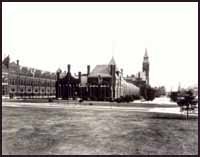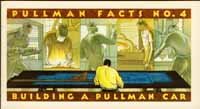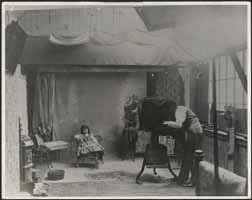The Pullman Company
You are at Home -> The Pullman CompanyDevelopment of the "Palace Car"
George Mortimer Pullman was always an inventive, innovative entrepreneur. Legendarily, an extremely uncomfortable overnight train ride from Buffalo to Westfield, New York, caused him to realize that there was a vast market potential for comfortable, clean, efficient passenger service. He had a great deal of experience with compact and efficient sleeping accommodations thanks to his experiences with canal boats on the Erie Canal. He formed a partnership with former New York state senator Benjamin C. Field in 1857, one of his close friends and neighbors from Albion, to build and operate several sleeping cars. Pullman and Field secured a contract from the Chicago, Alton and St. Louis Railroad to develop a more comfortable sleeping car. Pullman and Field converted two moderately successful cars. Field, more interested in politics than rail cars, assigned his interest to Pullman in exchange for future loans.1863 and the First Cars
Pullman returned to Chicago in April, 1863. Pullman built the Springfield, named after the town it was built in and President Lincoln's hometown, and the Pioneer. The cars were costly, comfortable, clean, and beautiful; the Pioneer alone cost $18,000 to build. In 1864, Pullman was also called to the draft, but like many young men with means, he hired a substitute to take his place in the Union Army.1868 and Expansion of the Company
With his own fortune and that of his investors, Pullman greatly expanded the company. He created his first hotel on wheels, the President, a sleeper with an attached kitchen and dining car. The food rivaled the best restaurants of the day and the service was impeccable. A year later in 1868, he launched the Delmonico, the world's first sleeping car devoted to fine cuisine. Both the President and the Delmonico and subsequent Pullman sleeping cars offered first-rate service which was provided by recently-freed former house slaves who served as porters, waiters, chambermaids, entertainers, and valets all rolled into one person. In January, Benjamin Field dissolved the partnership and the company became known as the Pullman Palace Car Company. The company charter was approved by the Illinois Legislature on February 22, 1867. The board of directors of the company elected Pullman as president and general manager. Pullman mostly handled marketing sleeping car services, while his brother Albert managed the manufacturing end of the operation. Lawyer Charles Angell, who later embezzled thousands of dollars from the company, handled the company's financial and legal affairs.1869 and Detroit
In 1869, Pullman bought the Detroit Car and Manufacturing Company to consolidate all of his manufacturing operations into one facility. He built 5 classes of cars: hotel cars, parlor cars, reclining room cars, sleepers, and diners. Pullman also aggressively pursued his competitors, buying out the Central Transportation Company, his main competitor, in 1870. By 1875, the company had built a successful business model, of leasing Pullman cars to railroads and providing complete service for the traveling public.Abraham Lincoln and the Pioneer
After President Abraham Lincoln was assassinated in April, 1865, his body was transported by the so-called Lonesome Train to Springfield for burial. From Washington, the funeral train bearing his body started west by slow stages. Across the country, mourners lined the tracks. By the time the cortege reached Chicago, Mrs. Lincoln collapsed. When arrangements had to be made for her return directly to Springfield, Pullman made his new Pioneer sleeper available. Pullman, a genius for public relations and a shrewd and intrepid businessman, so intrigued Andrew Carnegie that he became Pullman's largest investor. The Pioneer was the first, truly grand car that Pullman created. It was built in 1865 in the Chicago and Alton Rail Road Shed on the site of what is now Union Station in the Loop. It was the ultimate in sleeping cars with red carpeting, hand-finished woodwork, and silver-trimmed coal lamps. Cast iron wheel trucks topped with coil springs and rubber blocks provided a more comfortable ride. At $20,000, the cost of producing the Pioneer was extremely high. Pullman was sure people would pay for this comfort. The Pioneer was, indeed, luxury personified, but its height and width prohibited its use on existing track. When President Lincoln died, Colonel James H. Bowen, chairman of the Republican State Central Committee chose the Pioneer as a fitting part of the funeral cortege to accommodate the Lincoln family. Platforms and trestles were altered to accommodate the larger Pullman car, and thousands of people viewed the car as it made its way from Chicago to Springfield. This was a tremendous publicity boon for Pullman's company. The timing of its construction couldn't have been more fortuitous.The Growth of the Company
The popularity of Pullman's sleeping car service outstipped his production facilities. In 1880, Pullman bought 4,000 acres near Lake Calumet some 14 miles south of Chicago on the Illinois Central Railroad for $800,000. He hired Solon Spencer Beman to design his new plant there, and in an effort to solve the issue of labor unrest and poverty, he also built a town adjacent to his factory with its own housing, shopping areas, churches, theaters, parks, hotel and library for his employees. By 1883, Pullman had shops in St. Louis, Missouri; Detroit, Michigan; Elmira, New York; and Wilmington, Delaware as well as several factories in Europe and England. The company manufactured sleeping cars, boxcars, coal cars, baggage cars, chair cars, refrigerated cars, streetcars, and mail cars. In 1885, wages started at $1.30 per day. By 1897, unskilled workers earned $1.86, and journeymen mechanics earned $2.28 per day. The original working day was between 10 and 11 hours. Originally the Pullman Company paid workers disabled on the job half their salary. Mr. Sessions put an end to that suggesting that it encouraged malingering.Pullman's Death
After the death of George M. Pullman in 1897 Robert Todd Lincoln (1843-1926) assumed the presidency of the Pullman Palace Car Co. Lincoln remained president of the company until 1911. When Pullman died he left behind an estate of $7.6 million, 2490 railroad cars and a $63.5 million corporation. At this time the company had 90% of the sleeping car business in North America, and it had the largest railroad car plant in the world. In 1898, during this transition period the sewage farm was sold; it never being a successful operation for the efficient treatment of sewage. The brickyards located south of the community at 116th Street was sold and became the Illinois Brick Co. During the period after Pullman's death the company was rapidly restructured. The name was changed to the Pullman Company in 1899. In 1900 the company was to buy out its major competitor, the Wagner Palace Car Co. of Buffalo. This same year on September 1st the Calumet Shops were opened as a repair facility on what was the site of streetcar and interurban-car manufacturing. The Buffalo shop was then converted to a repair facility. These two shops were the last to be closed at the end of the Pullman era. Other major repair shops were located at Atlanta, Richmond, California, Wilmington, Delaware and St. Louis.Pullman Abroad
While Pullman attempted to establish his company in Europe he ultimately could not compete with George Nagelmackers, a Belgian, who formed a sleeping car service, the Compagnie Internationale des Wagons-Lits, that was headquartered in Paris. Pullman sold Nagelmackers his interests and operations in Europe in 1888. A company division was formed in England after the Pullman shop in Detroit furnished an English railroad with several cars. The Pullman name lives today in Europe, a symbol of elegance and luxury in a hotel chain in several countries and in North Africa. It is not unusual today to see "Pullman" tourist buses on European highways. Of course, these operations never had any connection with the original Pullman Co.Pullman Advertising
George M. Pullman was a master at advertising and marketing his services and train accommodations. Beginning with his earliest efforts at creating sleeping cars during the 1860s, he realized the marketing potential of "leasing" rather than selling his cars. By leasing them rather than selling them he was assured of their use by the greatest number of train lines, rather than just a few who could afford his more costly, elegant cars. As train lines expanded their services and ridership grew, so could the number of cars they leased from Pullman. Once Pullman's Palace Car Company was created and headquartered at Pullman, Illinois in 1881, marketing began in earnest with Pullman Palace Car Company descriptive circulars (1886) describing hotel, sleeping, excursion and hunting cars, the railroad companies leasing his cars advertised their advantages, and passes were issued allowing guests to travel during specified times. Publicity about the Town of Pullman and its famous train cars appeared in newspapers and journals across the country and overseas and for the Columbian Exposition of 1893, George Pullman created special "Market Square" apartment accommodations in the Town of Pullman for guests to stay and ran trains from the Exposition directly to Pullman. By the time of his death, Pullman had succeeded in making his name a household word. After George Pullman's death in 1897, the Pullman Company continued an aggressive advertising and marketing campaign throughout its lifetime. Hundreds of brochures, booklets, posters, and pamphlets were created over the decades that followed. Perhaps the most famous and well-known are the ads that appeared in magazines such as National Geographic, Life, the Saturday Evening Post, and Time, from the 1930s through the second War World and into the 1950s. Ads often had a theme and there were several series of ads such as the celebrity "I always travel by Pullman" series and and extensive series of wartime ads featuring American G.I.s. The Bertha Ludlam Archive has more than 100 original magazine ads in its collection and most have been digitized as part of the Industrial Heritage Archives project and are now available online.The 20th Century and the Decline of the Company
In March of 1907 Pullman produced its steel sleeping car the Jamestown for the Jamestown Exhibition in Virginia. At this time the south erecting shop at 111th Street and Cottage Grove Avenue was rebuilt to accommodate the heavier steel sleeping cars that the railroads demanded for safety reasons. The change from wood car construction to steel construction resulted in a change of the ethnic makeup of the work force. Up to this time the skilled members of the workforce were made up primarily of German, Swedish and Dutch workers. The change to a different technology saw this group gradually leave the company. Their replacements were usually from Italy and Poland. In the Chicago area one of the last major Pullman construction projects started in 1910 with the building of the 103rd Street freight car shops. During WWII this facility was converted by the Defense Plant Corporation to produce wing sections for the US Army Air Corps C47 and C54 transport airplanes. The best years for Pullman were the mid 1920s. In 1925 the fleet grew to 9800 cars. Twenty-eight thousand conductors and twelve thousand porters were employed by the Pullman Co. During the Great Depression rail travel declined because of the economy and competition from the automobile. In the 1950s the decline continued with traffic below 1930s levels and the airlines were carrying twice as many passengers as the railroads. In May of 1981 Amtrak sleeping car No. 32009, the George M. Pullman, was on exhibit for members of the community. At the completion of this contract Pullman-Standard for the last time shut the doors at the 111th Street Shop. The era of car building at Pullman, Illinois, which began in 1880, was closed. When the last car came off the line in 1981, the company invited the community to the shops in Building 100 on 103rd Street to visit this Amtrak sleeper. Today it still runs between Chicago and Seattle on Amtrak's Empire Builder.THE PULLMAN HISTORY SITE

More Information About the Pullman Company
Products from the Factory
Edison Films of Pullman Travel

From A Romance of the Rail, 1903
Other Pullman-Related Sites
- Historic Pullman Garden Club - An all-volunteer group that are the current stewards of many of the public green spaces in Pullman. (http://www.hpgc.org/
- Historic Pullman Foundation - The HPF is a non-profit organization whose mission is to "facilitate the preservation and restoration of original structures within the Town of Pullman and to promote public awareness of the significance of Pullman as one of the nation's first planned industrial communities, now a designated City of Chicago, State of Illinois and National landmark district." (http://www.pullmanil.org/)
- The National A. Philip Randolph Pullman Porter Museum is a 501(c)3 cultural institution. Its purpose is to honor, preserving present and interpreting the legacy of A. Philip Randolph, Pullman Porters, the Brotherhood of Sleeping Car Porters and the contributions made by African-Americans to America's labor movement. ((http://www.nationalpullmanportermuseum.com/)
- Pullman Civic Organization - The PCO is a strong and vibrant Community Organization that has been in existence since 1960. (http://www.pullmancivic.org/)
- Pullman National Monument - The official page of the Pullman National Park. (https://www.nps.gov/pull/)
- South Suburban Genealogical & Historical Society - SSG&HS holds the Pullman Collection, consisting of personnel records from Pullman Car Works circa 1900-1949. There are approximately 200,000 individuals represented in the collection. (https://ssghs.org/)
- The Industrial Heritage Archives of Chicago's Calumet Region is an online museum of images that commemorates and celebrates the historic industries and workers of the region, made possible by a Library Services and Technology Act grant administered by the Illinois State Library. (http://www.pullman-museum.org/ihaccr/)
- Illinois Digital Archives (IDA) is a repository for the digital collections libraries and cultural institutions in the State of Illinois and the hosting service for the online images on this site. (http://www.idaillinois.org/)







